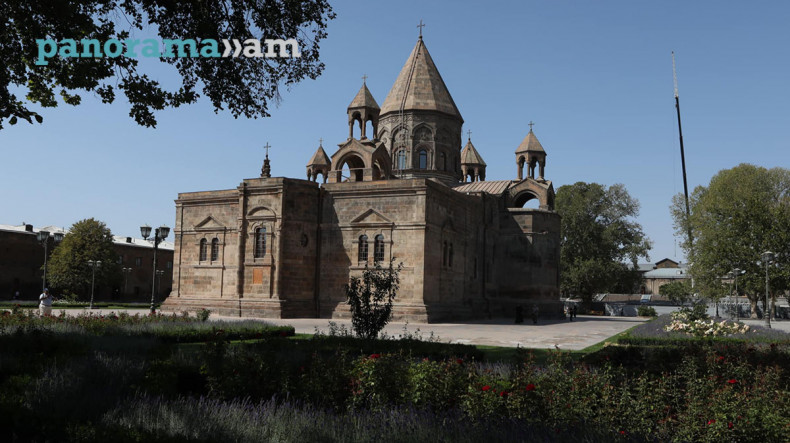
Armenian church commemorates St. George the Captain
The Armenian Apostolic Church on Saturday commemorates Sts George the Captain (George the Warrior), Adoktos and Romanos the Singer.
St George the Warrior is revered all over the world. He is one of the beloved saints of the Armenian church, whose life serves as an example of remaining faithful to God even under the harshest circumstances
Early Christian tradition tells us that St George was born to Christian parents in the late third century. After his father was martyred for his faith, his mother took the little boy back to her hometown Diospolis, now in the modern city of Lod in Israel.
St George became a soldier in the Roman army, and his bravery and discipline made him the climb ranks to become a captain. St George was steadfast in his faith, and, as a Christian, refused to bring the pagan sacrifice to the Roman emperor Diocletianus, which was venerating the emperor as a god. He was tortured and martyred around 303 AD.
While Saint George was being tortured, Alexandra, the King’s wife, went to the arena, bowed before George, and professed her faith openly. When she questioned whether she was worthy of paradise and martyrdom without being baptised, Saint George told her, “Do not fear, for your blood will baptise you.” She was denounced as a Christian and imprisoned on her husband’s orders then sentenced to death.
St George is often portrayed slaying a dragon. Christian tradition recounts that in a certain city, a dragon pestered the inhabitants, demanding two sheep a day. When there were no more sheep in the village, the vicious dragon demanded a human sacrifice.
The inhabitants cast lots, and the daughter of the city’s governor was chosen. When they were taking the crying girl to the dragon’s den, St George passed by. When he heard what was about to happen, he decided to intervene. He followed the girl into the den, crossed himself with prayer and slew the fire spitting dragon before it could attack. The citizens were in awe and recognised God’s powerful works. That day many were baptised and became Christians.
St George sets us an example in bravery, steadfastness and strong faith.
St Adoktos (Adauctus) was martyred in 320 AD. He was from Ephesus and was appointed governor by Emperor Maximin. Maximin asked Callisthene (Kalistene), the daughter of Adoktos, to marry him, but her father did not want to give her to an idolater. For being Christian, upon the King’s order, Adoktos was deprived of his title and property and exiled to Melitene. The local governor of Melitene also failed to convert Adoktos to the heathen religion. Remaining steadfast and unshaken in his faith, St Adoktos was beheaded.
His daughter Callisthene disguised herself as a young man and concealed herself in Nicomedia. She later on went to Thrace where she lodged with a family. Callisthene healed their blind daughter and the girl’s parents, who considered Callisthene to be a man, asked him to marry her. Then St Callisthene revealed the truth and they praised God.
Callisthene decided to leave in order to follow an ascetic way of life with humility. At the time, she met Constantia (Costantsa) the sister of Constantine the Great. The emperor defended and protected Callisthene and she managed to take back her father’s property and also to transfer his relics to Ephesus. She built a Church there in order to pay homage to him.
St Romanos the Singer (the Melodist) is considered to be the author and creator of more than 1,000 hymns or kontakia (hymns performed in Orthodox traditions).
According to legend, Romanos (Romanus) was not at first considered to be either a talented reader or singer. He was however, loved by the Patriarch of Constantinople, because of his great humility. Once, around the year 518, while serving in the Church of the Panagia at Blachernae, during the All-Night Vigil for the Feast of the Nativity of Christ, he was assigned to read the kathisma verses from the Psalter. He read so poorly that another reader had to take his place. Some of the lesser clergy ridiculed Romanos for this, and being humiliated he sat down in one of the choir stalls. Overcome by weariness and sorrow, he soon fell asleep. As he slept, the Theotokos (Mother of God) appeared to him with a scroll in her hand. She commanded him to eat the scroll, and as soon as he did so, he awoke. He immediately received a blessing from the Patriarch, mounted the pulpit and chanted extemporaneously his famous Kontakion of the Nativity, “Today the Virgin gives birth to Him Who is above all being….”
The emperor, the patriarch, the clergy, and the entire congregation were amazed at both the profound theology of the hymn and Romanos’ clear, sonorous voice as he sang. According to tradition, this was the very first kontakion ever sung. The Greek word “kontakion” refers to the shaft on which a scroll is wound, hence the significance of the Theotokos’ command for him to swallow a scroll, indicating that his compositions were by divine inspiration. St. Romanos passed away in 556 AD.